Hardy volunteers are a welcome gift from the garden. I have several reseeding annuals and biennials which each year enrich the garden. These plants which spring up where they please provide necessary filler and continuity within the borders. The advantage of volunteers is they weave themselves naturally into the garden. By doing so they hold the other plants together and give it a more relaxed feel. Also, they sometimes pop up where I would not have thought of planting them or could not have planted them. Reseeders also fill any holes in the plantings offering a sense of abundance. I have two types of volunteers: accent plants and unifiers.
 Amaranthus 'Hopi' is a very tall, red stemmed plant which I grow in the Cutting Garden, Egg Garden, and Long Border (it is pictured here between the Egg Garden and the Front Border). I bought Hopi from Annie's Annuals three years ago. It is a generous self seeder which requires thinning out of the seedlings in the spring since I only want about five or six plants. The birds love the seeds so I usually don't worry about too many seedlings. I also cut off some of the flowers as the seeds mature to keep for fall decorations.
Amaranthus 'Hopi' is a very tall, red stemmed plant which I grow in the Cutting Garden, Egg Garden, and Long Border (it is pictured here between the Egg Garden and the Front Border). I bought Hopi from Annie's Annuals three years ago. It is a generous self seeder which requires thinning out of the seedlings in the spring since I only want about five or six plants. The birds love the seeds so I usually don't worry about too many seedlings. I also cut off some of the flowers as the seeds mature to keep for fall decorations. When the amaranthus is young, I transplant some into containers or to other spots where I want them to grow. I keep more in the cutting garden for arrangements and to be dug up at a later date to fill in any holes which develop.
Sunflowers are always welcome. Due to the birds, I only get a few of these, but they are greatly appreciated.
 Inspired by Mottisfont Abbey (http://www.nationaltrust.org.uk/main/w-vh/w-visits/w-findaplace/w-mottisfont/), I have white foxglove in the Rose Garden. Most of the seedlings which I don't thin out grow in situ, but others are moved to the Cutting Garden. I try to keep the foxglove in the Rose Garden white, so any which bloom non-white are cut for arrangements. If you don't like having the spent flower stem left up, it works quite well to cut the stalk and lay it on the ground. I find that once the upper most flowers have bloomed the seeds from the bottom ones are mature. Cutting the stems also has the added advantage of stimulating the plant to produce more flowering side shoots.
Inspired by Mottisfont Abbey (http://www.nationaltrust.org.uk/main/w-vh/w-visits/w-findaplace/w-mottisfont/), I have white foxglove in the Rose Garden. Most of the seedlings which I don't thin out grow in situ, but others are moved to the Cutting Garden. I try to keep the foxglove in the Rose Garden white, so any which bloom non-white are cut for arrangements. If you don't like having the spent flower stem left up, it works quite well to cut the stalk and lay it on the ground. I find that once the upper most flowers have bloomed the seeds from the bottom ones are mature. Cutting the stems also has the added advantage of stimulating the plant to produce more flowering side shoots. Sweet William, a biennial, is another heirloom plant which is extremely easy to grow, but often overlooked (pictured here under the wisteria). The flowers of the older varieties like Holborn's Glory are fragrant and make a nice edging in the front of a border. I have these in the Cutting Garden and Long Border.
Sweet William, a biennial, is another heirloom plant which is extremely easy to grow, but often overlooked (pictured here under the wisteria). The flowers of the older varieties like Holborn's Glory are fragrant and make a nice edging in the front of a border. I have these in the Cutting Garden and Long Border. Queen Anne's Lace is confined to the Cutting Garden as it is great mixed with other cut flowers. It took me several years to get it to grow which leads me to believe that the freshness of the seed makes a great difference in establishing it. Since then, I have had no problems keeping it. With fresh seed it reseeds quite a lot; after all, it is a weed to many. To prevent it from going beyond its welcome, I do not allow it into other areas of the garden; I cut a lot of it; and I thin it out when I have too much.
Queen Anne's Lace is confined to the Cutting Garden as it is great mixed with other cut flowers. It took me several years to get it to grow which leads me to believe that the freshness of the seed makes a great difference in establishing it. Since then, I have had no problems keeping it. With fresh seed it reseeds quite a lot; after all, it is a weed to many. To prevent it from going beyond its welcome, I do not allow it into other areas of the garden; I cut a lot of it; and I thin it out when I have too much. Spider flowers (cleome) are big and are sometimes hard to plant in the garden without them looking like stiff soldiers. But once spider flowers are allowed to self seed, it transforms them. They look very natural growing through other plants and often to different heights depending on where they are. They also have a range of color. In the front of Goldberry Hill, I only allow violet ones. In the Egg Garden, I try to keep more white than pink. In the Children's Garden (pictured), they are mostly pink because my daughter loves pink. Also, as the first plants become leggy, plants from seed which germinated later reach up to cover up the old bare stalks.
Spider flowers (cleome) are big and are sometimes hard to plant in the garden without them looking like stiff soldiers. But once spider flowers are allowed to self seed, it transforms them. They look very natural growing through other plants and often to different heights depending on where they are. They also have a range of color. In the front of Goldberry Hill, I only allow violet ones. In the Egg Garden, I try to keep more white than pink. In the Children's Garden (pictured), they are mostly pink because my daughter loves pink. Also, as the first plants become leggy, plants from seed which germinated later reach up to cover up the old bare stalks. 









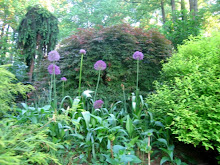
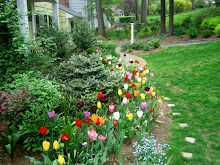
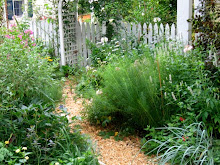
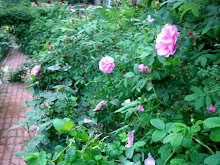

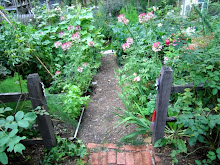

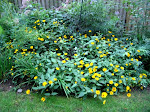





12 comments:
This was a wonderful post, and thanks for showing us many parts of your lovely garden. The volunteers are treasures in our garden, like you say, choosing places to grow we ourselves would not have thought of.
Frances at Faire Garden
Wow you have a wonderful garden. It's so very plush looking if that makes any sense. I love at the plants you named off. Some of the plants I've never heard of and will be searching right now to find out more. Sweet William are one of my favorites I have some growing right now and can't wait to see them flower. I'll keep these in mind to try when I have a garden and not a balcony. I like how you have different sections in your garden. That's a wonderful idea to have certain themes going on.
What a fantastic post! I love self seeders and yet see many here I didn't know about. Verbascum is a favorite of mine, I had to sneak across the street and dig it out of their curb one night to get it started here :-)
Never though about the sweet williams, I'll have to add some this year.
Thanks for the information. I have several of these winter sowing now. They should do fine since they readily self-seed.
What a wonderfully informative post this is! I just wish some of the self seeders would selfseed here--never has V. bonariensis returned for me. I live in hope...this year I'm seeding it directly into the garden, plus growing some as transplants, and if I can get my mitts on some transplants at a nursery, I'll put them in too. ONe of the most lovely annuals I've ever seen!
thanks for the plant tips.
I like how you gave so much thought to how each plant will grow and mature so the whole garden flows. I start out thinking that and then I see something I can't live without. I too have many of the plants you recommended. But..they will be going to the person who buys my house. Boo hoo.
The only persistent hardy volunteer in my garden is the Californian Poppy. I bought some seeds about 10 years ago and they turn up everywhere! I love them.
It is fun to see where Cleome will pop up in the garden. They seem to move about. I have never seen birds eating the seed and I don't purposely scatter them so I am always amazed when they pop up here and there.
Matron,
I'm trying to get the poppies to self seed, but I haven't gotten them to work yet. Maybe this year!
Heirloom Gardener
Thanks for the advice on Verbascum bombyciferum. I haven't had success in my heavy clay. Now I know to try it in the most well drained place I can find and let its seeds practice their own "natural site selection." That's what our native mullein has done, but it can't come close to V. bombyciferum for visual effect.
In my view everyone have to glance at it.
Post a Comment